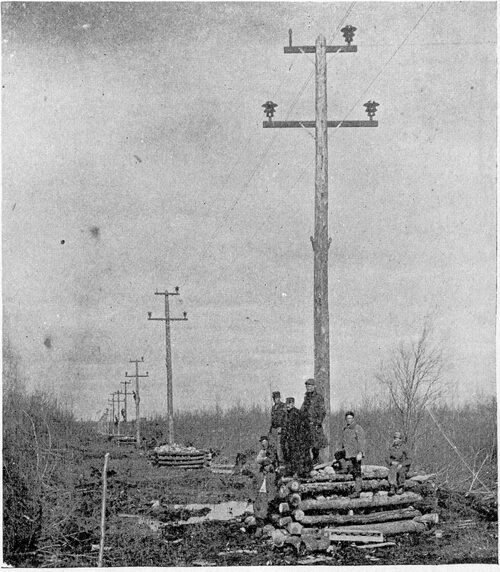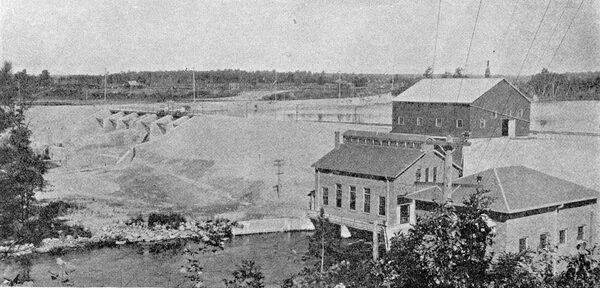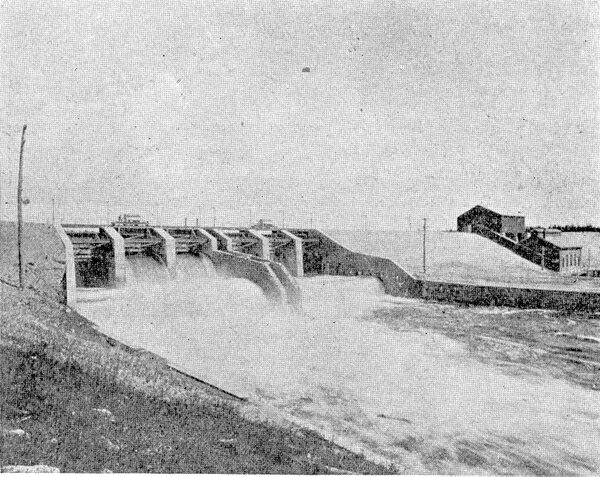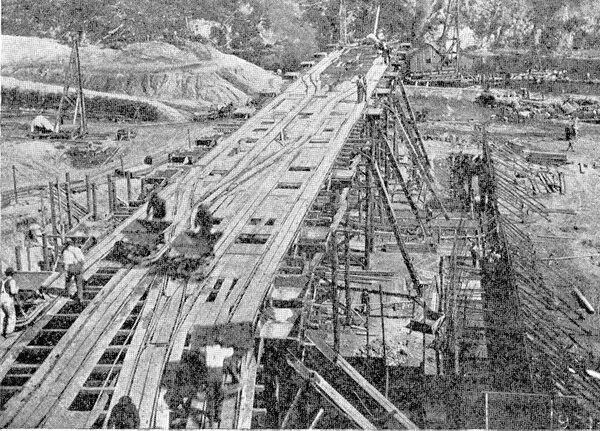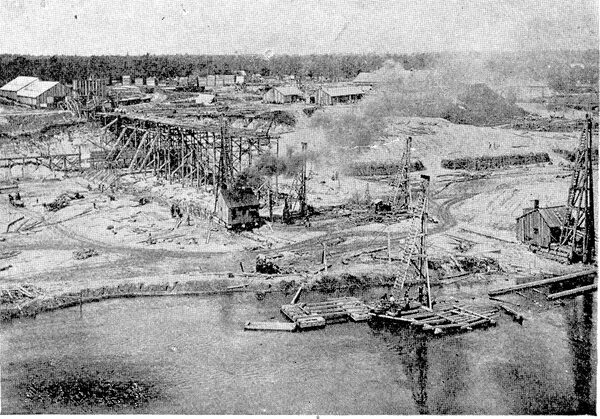[Trade Journal]
Publication: Electrical World
New York, NY, United States
vol. 48, no. 18, p. 841-2, col. 1-2
The Grand Rapids-Muskegon 66,000-Volt
Transmission System.
SINCE April 1, 1906, the Grand Rapids-Muskegon Power Company, of Grand Rapids, Mich., has been transmitting power at 66,000 volts. For some time recently the voltage has actually been 69,000. The accompanying map (Fig. I) shows the transmission lines, power stations, sub-stations and territory served by the company. The 66,000-volt transmission live from Rogers Dam with branches to Grand Rapids and to Muskegon totals about 7 miles. The distances between various important points are given on the map. The power house at Croton Dam has not yet been completed. The present transmission is from Rogers Dam by way of Casnovia switch station to Muskegon and Grand Rapids. Power for operating the Grand Rapids, Grand Haven & Muskegon Railway and the Grand Rapids, Holland & Chicago Railway is all supplied by this company, part of it being stepped down from 66,000 volts for use in the rotary converters at sub-stations near the ends of these lines, the remainder being stepped down to 19,000 volts for transmission over high-tension lines owned by the railway companies for transmission from their steam power houses before the present water power plant was built.
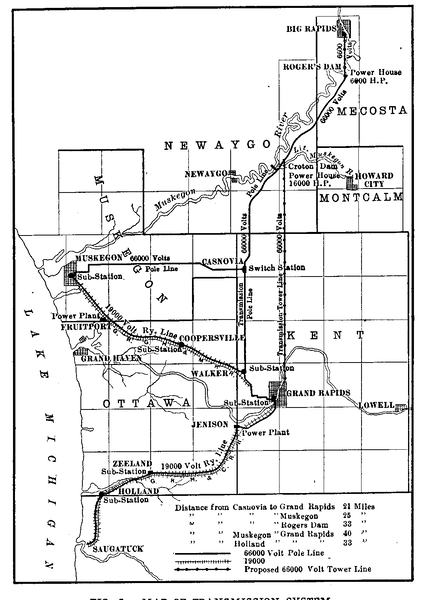 |
| Fig. 1 -- Map of Transmission System. |
Fig. 2 is a view of a pole line crossing swampy ground. The wires are placed 6 ft. apart. On the top cross arm at the left is a No. 6 iron wire which is grounded every fifth pole for lightning protection. Locke insulators are used 14 in. in diameter over all and 18 in. high. Wooden pins are used on straight line work and iron pins on the corners. These pins are 18 in. over all and 2 in. in diameter under the shoulder. The same dimension of pin is used for both wood and iron. The transmission line conductors are No. 2 solid copper wire. Poles are from 45 to 60 ft. long, none less than 45 ft. being used. They are of Michigan and Idaho cedar and Southern cypress. Forty poles are placed per mile. A right of way from two to four rods wide was purchased. Besides the 66,000-volt pole lines now in operation, which are shown on the map, a transmission line on steel towers direct from Croton Dam to Grand Rapids is planned as indicated. This line will be of at least 66,000 volts and possibly may be operated at 100,000 volts. This line and the Croton Dam power house will probably be completed next May. The tower line with the existing pole line will give a duplicate line between Croton Dam (which is the largest power house) and Grand Rapids. The principal object of the duplicate line is stated by the management to be to avoid interruptions due to local thunderstorms. Thunderstorms in this locality are very local in character and a storm affecting one line might not affect the other. The new steel tower line will be on triangular steel towers 500 ft. apart, similar to the Canadian Niagara tower line.
| |||
| Fig. 2 -- 66,000-Volt Line, Grand Rapids-Muskegon Power Co. |
The operation of the 66,000-volt line up to present writing has been entirely satisfactory and as free from trouble as any high-tension line. The only interruption was that due to the shattering of two insulators by lightning, these insulators being on the two poles next to a railroad crossing. The insulators were split in two by the discharge.
The grounds for the grounded wire are made by burying a coil of copper wire under every fifth pole. Static interrupters, choke coils and Westinghouse lightning arresters are placed at the power and sub-stations. The power plant at Rogers Dam near Big Rapids, which is now in operation, has an average capacity of 6,000 hp. The minimum flow of the river will give 4,000 hp. The head of water is 45 ft. There are two 15,000-kw, direct-connected, three-phase, revolving-field, Westinghouse 6,000-volt, 30-cycle generators with exciters on the same shaft. Each of these generators is connected to two pairs of Leffel horizontal shaft turbines running 225 r.p.m. The turbines are 45 in. in diameter and are of the center discharge type. Lombard water wheel governors are used, with Tirrill voltage regulators on the generators. There is one bank of three 1,200-kw transformers in this station, the excess capacity being provided so that in emergencies the output of the station may be delivered through two transformers. Oil switches are provided in both the 6,600-volt primary and 66,000-volt secondary circuits. The 66,000-volt coils are connected delta.
| |||
| Fig. 3 -- Power House at Rogers Dam. |
Figs. 3 and 4 show Rogers Dam and its power house. Figs. 5 and 6 show the construction work now going on at the larger plant at Croton Dam. This Croton plant is to have a capacity of 16,000 hp, the head being 50 ft. Two 3,000-kw generators will be installed at the start. Each generator is to be direct-connected to four pairs of turbines. Besides these two plants the company has purchased water rights for three and possibly four more dams along this river so as to give it a total of 60,000 hp.
| |||
| Fig. 4 -- Rogers Dam. |
| |||
| Fig. 5 -- Croton Dam Construction Work. |
| |||
| Fig. 6 -- Croton Dam Construction Work. |
The sub-stations at Grand Rapids and Muskegon are fire-proof buildings provided with cranes for handling apparatus. Each has three 1,200-kw transformers stepping down from 66,000 to 6,600 volts. A 1,000-kw motor-generator changing from 6,600 volts and 30 cycles to 2,300 volts and 60 cycles is being put in and a 1,000-kw rotary convert has also been ordered and will be installed later on.
As before stated, the company is supplying all the power to the two interurban roads operating into Grand Rapids. It also has contracted to supply power to the Grand Rapids Edison Company and to several large factories. The Brunswick-Balke-Collender Company, a large manufacturer of billiard room furniture and supplies, recently moved its factory to Grand Rapids, one of the things which influenced the change being cheap electricity. This company takes 800 hp. The Shaw Electric Crane Company takes 400 hp. There are many other large factories in Grand Rapids which are now or will soon be connected, these factories being now operated by their own steam plants. At present all of the power developed at the Rogers Dam is being sold and delivered, the work on this dam being started only a year before the plant itself was started. A force of 125 line construction men has been worked continuously. When the second dam at Croton is completed the company will go into commercial lighting in Grand Rapids.
The capitalization of the company stands as follows: Capital stock - Preferred 6 per cent cumulative, authorized, $1,500,000; issued, $600,000. Common, $1,500,000 authorized; $1,500,000 issued. First mortgage bonds - Reserved for issue under restrictions in the trust deed, $6,329,000 authorized. Total bonds outstanding, $1,171,000. The company's general offices are at Grand Rapids. The manager is Mr. Anthony J. Bemis, to whom we are indebted for the information contained in this article. The hydraulic engineer was Mr. W. J. Fargo and the electrical engineer Mr. J. B. Foote, both of Jackson, Mich. The officers of the company are: President, Thomas Hume, Muskegon, Mich.; vice-president, W. A. Foote, Jackson, Mich.; treasurer, J. G. Emery, Muskegon, Mich.

